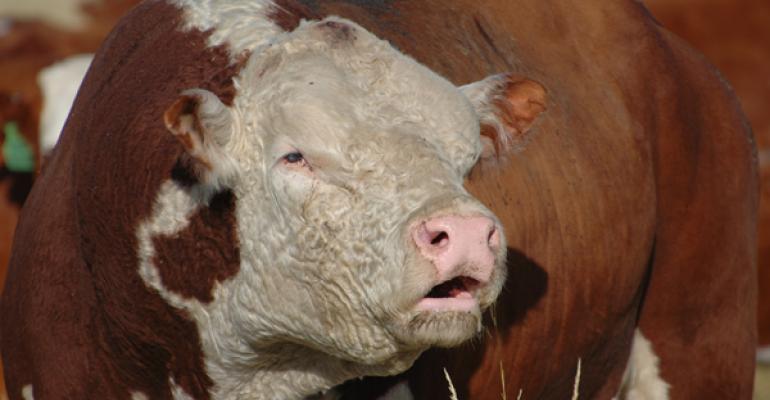Accelerated genetic progress
Potential use of gene editing likely will have plenty to do with the regulations imposed by different nations.
October 16, 2019

Sponsored Content
“I think of gene editing as a little bit like the cherry on top of the breeding ice cream sundae,” says Alison Van Eenennaam, Extension animal genomics and biotechnology specialist at the University of California-Davis. “Nothing about our traditional breeding programs will go away because of editing, but it offers us the ability to introduce useful alleles without linkage drag and also to bring in useful novel genetic variation from other species.”
Van Eenennaam provided an update about gene editing development at last summer’s Beef Improvement Federation Research Symposium and Convention.
Gene editing is nothing new.
Mother Nature has done it since the beginning of time, randomly, via naturally occurring gene mutations.
Deliberately encouraging gene mutation and increased genetic variation is old hat, too. Plant breeders in the 1950s exposed seeds to ionizing radiation to cause double-stranded breaks in DNA at random locations throughout a plant’s genome. That created more genetic variation, from which they could select desirable traits.
Referring to the genomic sequencing of 2,700 bulls (1,000 Bull Genomes Project), Van Eenennaam explained there are 86.5 million genomic alterations between perfectly healthy bulls of different breeds; that’s nature doing the editing.
In simple terms, breakages naturally and commonly occur in the double-stranded helixes of DNA. Nature tries to repair them. When done incorrectly, genetic variation occurs (see Directing Nature).
New developments
What’s new in recent years is the ability to precisely and deliberately create DNA breakages and repair them just as precisely.
Current examples include everything from creating a polled Holstein bull to producing tuberculosis-resistant cattle, to increasing lean muscle yield in cattle, to producing pigs resistant to Porcine Reproductive and Respiratory Syndrome.
The aforementioned homozygous polled Holstein bull was the result of replacing Holstein’s horned allele with a polled allele from Angus. This was accomplished by UC-Davis, in collaboration with Acceligen, the agricultural division of Recombinetics. The bull was crossed with horned Hereford cows, which resulted in all polled calves, as expected.
Keep in mind, the polled allele exists in the Holstein breed, but infrequently. Heretofore, none of the polled Holstein were superior enough in other traits to get much use. The point is, the man-made genetic mutation mirrors what occurs naturally. With editing, though, the trait can be incorporated into genetically superior lines of cattle.
Currently, no one in the U.S. would want to buy semen from the gene-edited bull, even if it was available.
That’s because U.S. regulations, administered by the Food and Drug Administration, view the bull as a genetically modified organism (GMO)—a new animal pharmaceutical, in this instance. As such, there’s a mandated extensive, years-long, multi-generational pre-market approval process. Without approval, neither the bull nor any of his offspring’s production can enter the U.S. food supply.
That’s exactly opposite of current regulations proposed for gene editing plants. In simple terms, if the plant could have been produced through conventional breeding, it would not be subject to GMO regulations.
Governmental views of genetically modified animals also vary widely between countries.
In Canada, for instance, Van Eenennaam explains the regulatory process evaluates product risk, not the breeding method for producing the product. If there is no novel product risk, then it’s not regulated as a GMO.
Recombinetics has an alliance with Semex, a Canadian producer-owned semen and A.I. company, which is aimed at incorporating the polled allele in elite dairy genetics.
There is some hope in the U.S. Last summer, the White House issued the Executive Order on Modernizing the Regulatory Framework for Agricultural Bio-technology Products. It states the federal government’s policy as, “…protect public health and the environment by adopting regulatory approaches for the products of agricultural biotechnology that are proportionate responses to the risks such products pose, and that avoid arbitrary or unjustifiable distinctions across like products developed through different technologies.”
Points in support of that policy include making, “… regulatory determinations of products based on risks associated with the product and its intended end use; and using existing statutory authority, as appropriate, to exempt low-risk products of agricultural biotechnology from undue regulation.”
Besides government regulations, consumers will ultimately decide whether or not to accept genetically modified animals. Over time, their views of genetic modification in plants and livestock are inconsistent, at best. However, recent research suggests they’re more likely to view it positively, if they believe it contributes to animal wellbeing.
For instance, Van Eenennaam shared results of a study this year, Public Attitudes Towards Genetically Modified Polled Cattle. Researchers concluded, “The majority of participants reported positive attitudes towards gene modified polled cattle and a willingness to consume products from these animals. Participants often discussed issues related to animal welfare in support of their views. These results suggest that participants may be more likely to support gene modification technologies when these are perceived to benefit animal welfare.”
About the Author(s)
You May Also Like




.png?width=300&auto=webp&quality=80&disable=upscale)
